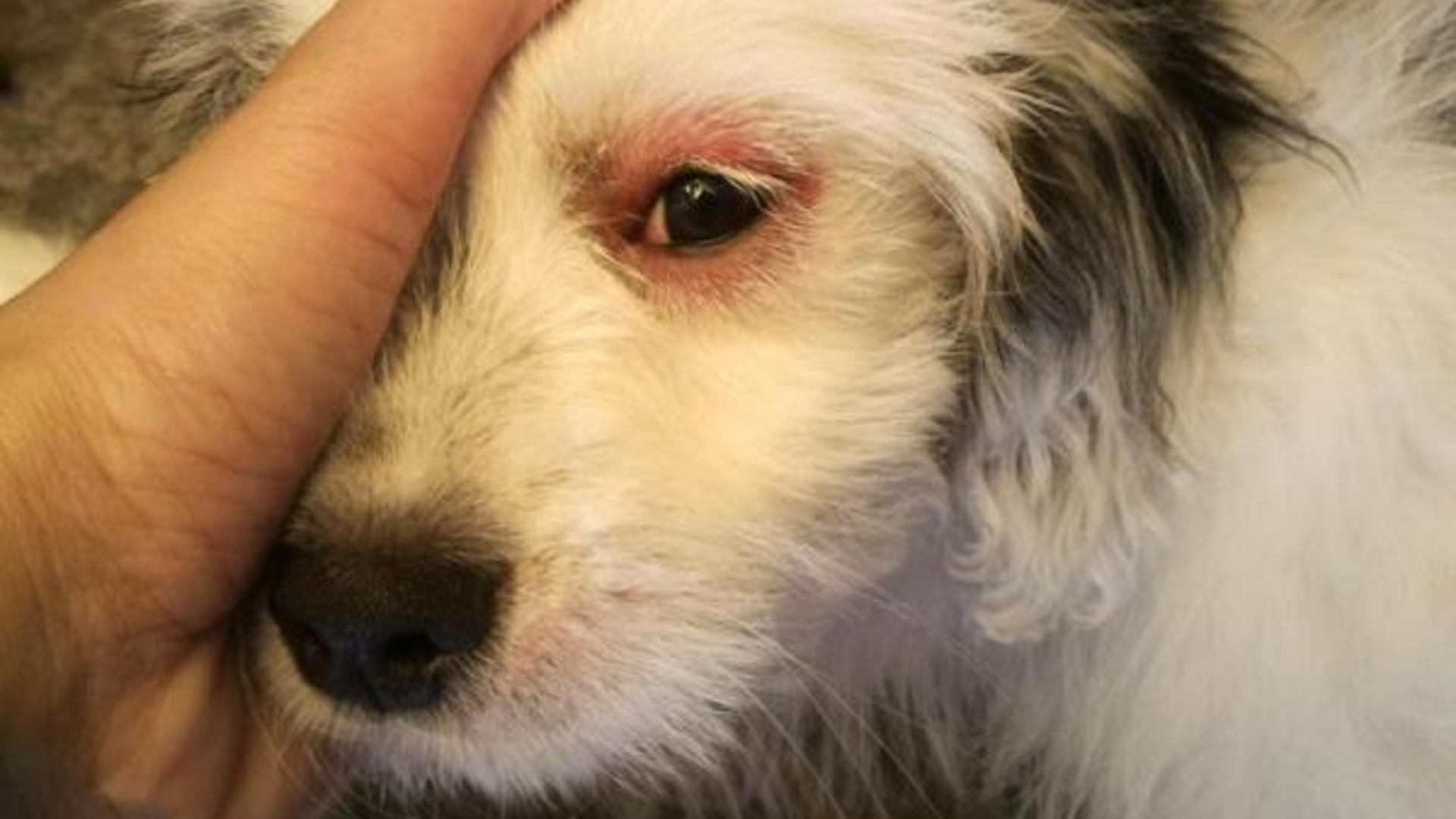Conjunctivitis in dogs
Conjunctivitis is a common condition in dogs, which can be caused by a variety of things, often benign, but sometimes more serious.
In order to determine what to do if your dog has a red or watery eye, it is necessary to first identify the cause of the problem. If the best thing to do is to take your pet to a health professional, namely a veterinarian, it is still very useful to know a little more about the main causes and consequences of conjunctivitis in dogs, and the reasons why you should have your dog treated by a professional.
What is conjunctivitis in dogs?
Conjunctivitis is an inflammation of the conjunctiva, the membrane lining the outside of the sclera (white of the eye) and the inside of the eyelid. The role of the conjunctiva is to insulate and protect the eyeball from the external environment and from pathogens that evolve in it.
The conjunctiva is a particularly vascularized tissue, which quickly turns bright red in case of inflammation. Nevertheless, in dogs, it is often not very visible due to the morphology of the canine eye which hides the sclera and, contrary to what one might think, conjunctivitis is therefore not always easy to diagnose.
Conjunctivitis occurs when the conjunctiva shows signs of inflammation, namely redness and sometimes edema (swelling). Conjunctivitis may be accompanied by other clinical signs, such as liquid and translucent or thick and opaque eye discharge, which may be of different colors (brown, white, green, yellowish...), ulcers or chemosis (swelling of the inner eyelid).
Atypical forms may also occur, resulting in the appearance of small nodules or other non-specific ocular lesions (uveitis, keratitis, etc.).

Causes of conjunctivitis in dogs
In the majority of cases, conjunctivitis in dogs is not serious - unlike in cats, where it is often chronic, continuing for life. However, mild does not mean insignificant, and it is important to get it treated to avoid more serious, and potentially incurable, complications.
On the other hand, it should be noted that conjunctivitis is sometimes a symptom of a more serious and systemic disease, which threatens other organs of your dog. To rule out this possibility or, if it occurs, to implement early treatment, it is all the more important to consult a veterinarian if your dog presents redness or watering of the eye.
Dogs with conjunctivitis due to trauma
Many dogs are adventurous little balls of energy that like to bicker with their peers, run into bushes or jump around, risking injury. Trauma also makes them ideal culprits in cases of sudden conjunctivitis, when your dog comes home from a walk or ends a play session with a red eye. A scratch, a favorite ball accidentally hit the eye, branches... Small accidents that can lead to conjunctivitis are legion in a dog's daily life. Note that a trauma is not necessarily caused by an object or another dog: the animal's own hair, and in particular badly implanted eyelashes, can traumatize the conjunctiva and cause inflammation.
Dog conjunctivitis and foreign body in the eye
In the same vein as traumatic conjunctivitis, conjunctivitis due to a foreign body (twig, grain of sand, hair, gnat, etc.) can cause more or less impressive ocular irritation. This type of conjunctivitis usually manifests itself by a reddened sclera, excessive tearing and a half or fully closed eye. In this case, rinsing the eye thoroughly with saline solution may be all that is needed to remove the cause of your dog's discomfort. If the conjunctivitis persists a few hours after this operation, a veterinary consultation is necessary to properly remove the foreign body, to make sure that there is no ulcer and, eventually, to implement an antibiotic treatment to avoid any risk of infection.
Conjunctivitis in dogs due to an inherited eyelash defect
As mentioned earlier in this article, a defect in the implantation of the eyelashes can cause conjunctivitis in dogs. There are three types of hereditary defects that can irritate the conjunctiva: distichiasis, where the eyelashes are abnormally implanted and often overgrown, trichiasis, where the eyelashes are correctly implanted but misaligned, and ectopic eyelashes, abnormally implanted and misaligned (usually located on the inner side of the eyelid). Defects in eyelash implantation and orientation are often genetic, and certain breeds are predisposed to them (Yorkshire, Pekingese, Bulldog, etc.). Apart from these particular disorders, certain breeds of dogs have a morphology that favors ocular irritation. Brachycephalic dogs (Boxer, Bulldog, Pekingese, etc.) can have such a short nose and wrinkled skin that the hair on their faces can sometimes touch their eyes. The same is true with dogs with prominent eyeballs (Chihuahua, Cavalier King Charles, Cocker Spaniel, etc.) whose eyes are more fragile and very exposed.
Dog conjunctivitis and allergies
Many pathogens circulating in our environment can cause allergies in dogs. From mites, dust, pollen and even food, allergies in dogs are neither rare nor episodic. Although common, allergic conjunctivitis is far from easy to treat. In fact, finding the offending allergen can be a long and arduous process, with expensive medical tests.
Dog conjunctivitis and tear disorder
Some dogs develop dry eyes, usually due to an underlying condition, sometimes severe - such as diabetes. The animal does not produce enough tears, and dust and pathogens accumulate in the eyes, causing conjunctivitis. This type of pathology must be promptly consulted by a veterinarian, who is the only one able to determine the cause of the problem and to implement an appropriate treatment.
Dog conjunctivitis and eye infection
Bacteria, fungus and even viruses can cause eye infections that manifest as conjunctivitis, usually accompanied by purulent discharge. It is important to note that this type of infection is not always local: a systemic infection - particularly viral - may be involved. This is the case with distemper or leishmaniasis, diseases caused by viruses that cause - among other things - ocular symptoms. More rarely, eye infections in dogs can be linked to cancer or metabolic diseases.
Consequences of conjunctivitis in dogs
The consequences of conjunctivitis in dogs depend on both the cause and the speed with which it is treated.
As this condition can hide a more serious disease, it is essential to consult a veterinarian if the symptoms do not disappear within a few hours after rinsing the animal's eye or in case of purulent discharge.
In the case of traumatic or foreign body conjunctivitis, the cornea of the dog's eye may ulcerate, become infected, and the lesion may become severely complicated if not properly treated, leading to blindness.

Treatment of conjunctivitis in dogs
Treating conjunctivitis in dogs requires first identifying the cause, which only a professional veterinarian can do. It is therefore essential not to neglect this eye condition in dogs, even though it may seem benign - and in most cases it is.
However, the context of your dog's conjunctivitis can provide valuable clues: if your dog's eye is red and watery just after a long romp in the bushes or after a lively play session, trauma or a foreign body may be a legitimate possibility. In this case, if the dog doesn't seem to be in too much pain and doesn't keep his eye completely closed, you can try flushing it out before taking him to the vet.
To do this, use neutral saline in a sterile pipette, like the one used to clean the eyes of human children. Do not use any other product without the approval of your veterinarian. Rinse your dog's eye thoroughly, and wait a few hours while keeping a close eye on your dog. If the conjunctivitis does not go away quickly, take your dog to the vet right away.
It is possible that a foreign body is deeply lodged in your pet's eye, or that trauma has caused significant damage (ulcers) that cannot be seen by the naked eye. In all other cases (conjunctivitis due to allergies, infections, ectopic eyelashes, lacrimal disorders...), only a veterinarian will be able to diagnose and prescribe an appropriate treatment.
FAQ
How do you flush a dog's eye?
You can use saline to flush your dog's eye if you think a foreign body is likely the cause of his conjunctivitis. Use only neutral baby saline, available at your local pharmacy, and rinse your pet's eye thoroughly.
What should I do if my dog has conjunctivitis?
There are many causes of conjunctivitis in dogs, some of which are particularly serious (distemper, diabetes, cancer, etc.). To rule out any serious cause and put a quick end to your dog's troubles, consulting a veterinarian is the best thing to do. Note that even benign conjunctivitis can become complicated and must be treated.
How do I know if my dog has conjunctivitis?
Conjunctivitis is an inflammation of the connective tissue that covers the inner surface of the eyelids and the sclera of the eye. It results in a red eye (or both) and a sometimes swollen eyelid. Discharge may occur in a wide range of colors (translucent, white, brown, yellow, green...). The animal may also feel itchy and scratch the eye, which tends to worsen its symptoms, and keep the eye slightly or completely closed.
How serious is conjunctivitis in dogs?
Conjunctivitis in dogs occurs in reaction to a third party phenomenon, it is never spontaneous. It can therefore be due to serious illnesses, such as a simple dust in the eye, an allergy or a small shock. In fact, it is not systematically serious, but can quickly become complicated if left untreated.
My dog has conjunctivitis, should I take him to the vet?
It is strongly recommended that you take your dog to a veterinarian if he has conjunctivitis, as this condition can be a sign of serious illness. In addition, conjunctivitis from benign causes can become complicated when not properly treated. However, if you think your dog has simply gotten a speck of dirt in his eye, you can try rinsing it out yourself with a suitable product before visiting a veterinarian if the symptoms don't go away in a few hours.
Conjunctivitis in dogs is usually benign, but it should not be taken lightly to avoid complications and to diagnose the underlying condition as soon as possible. To be well prepared to deal with all your dog's little boo-boos, it is recommended to always have baby saline in your dog's first aid kit.
Rinsing your dog's eye can be a lifesaver when he comes back from a walk or play session with a red eye, the cause of his troubles being probably a small foreign body lodged in his eye. For all other conjunctivitis, those which do not appear in an explicit context, it is advisable to go quickly to a veterinarian who will make a diagnosis and prescribe an adapted treatment.

